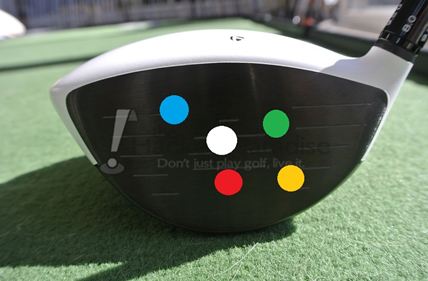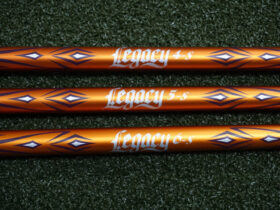TaylorMade R1 Driver Review

Here’s a remarkable statistic for you to digest. During a three month stretch in 2012, 78% of all metal woods sold were white.
Eight out of ten.
We started getting hints about the next generation driver from TaylorMade’s flagship R series through TV ads that are now becoming quite familiar. The long hitting, driver loving TaylorMade Tour staff gathered around a box, whistled, muttered an expletive or two and sent the internet into frenzied discussion. Since then we’ve seen Justin Rose in war paint and two PGA Tour victories in two weeks. Is it all a bit much? Maybe, but who am I to argue with the company that can pull off that little number I shared above.
Love it or not, the R1 is making noise.
One Driver
The name says it all. The R1 comes in a single loft and 12 different loft combinations all at once. Consumers won’t have to decide among a number of options to buy, but instead will be able to ‘tune’ one driver to the loft, face angle, and shot shape they desire.
This is an incredibly simple, yet remarkably complicated idea all at the same time. Simple because having one head to choose from makes for an easy shopping experience, but complicated because there is a certain amount of knowledge and equipment required to get an ideal set of launch conditions. If drivers could talk, the R1 would say, “Go see a fitter.”
Three Tunable Technologies
In the absence of a fitting, TaylorMade does provide resources that should help consumers learn to get the most out of the R1. First, there is an app called R1 Virtual for both Android and iPhone devices that can be downloaded for free. There are also videos out there on youtube.com that offer good instructions, along with some neat graphics. Lastly, there’s a handy webpage on TaylorMade’s website that I found the most helpful. I’m going to give a little rundown of three basic elements of the tuning experience here as well.
12 Position Loft Sleeve

The first step in R1 tuning is centered on loft and the adjustments are made via the adapter at the end of the shaft, which has a few new settings when compared to previous R series drivers. The result is a 4° range of lofts to choose from – seven settings from 8° to 12°, in addition to five settings with an upright lie angle.
Here’s a little information from TaylorMade regarding driver loft.
“Offering a wide range of loft settings is imperative, because our research indicates that 80 percent of golfers are playing the wrong loft, which costs them distance,” said Dr. Benoit Vincent, chief technical officer. “The R1 offers 12 positions to help golfers find the loft that delivers the launch conditions that deliver maximum distance.”
Why are so many golfers playing the wrong loft?
1) Golfers typically choose the wrong loft when they buy off the rack, usually opting for too little loft because of a long-held belief that a lower-lofted driver will promote long distance. In fact, a low-lofted driver typically costs the average player carry and distance by promoting a too-low launch angle.
2) Changes to driver design during in recent years to promote lower spin (such as moving the CG location lower and forward) has made it possible for many players to switch to a higher loft that promotes more carry and distance by achieving a better combination of high launch/low spin launch conditions.
7 Position Face Angle Sole Plate

With adjustable drivers like the R1, loft changes alter face angle. The R11 was the first TaylorMade driver to offer a sole plate, which is designed to give the consumer the ability to get the face angle back to the position of his or her preference. For the sole plate to work, the driver must be grounded at address.
The R1’s sole plate is beefed up compared to previous models, with 7 positions ranging from 3° open to 3° closed. It seems simple enough, though there is a somewhat confusing element to it. The sole plate is used to offset loft changes, so a driver set at 12° loft will need to have the sole plate set to 3° open to achieve the appearance of a neutral face angle. If that sounds confusing, it’s because it sort of is. I’d love to see this simplified a bit in the future. Again, I’ll mention the resource available on TaylorMade’s website, so you can see exactly what loft and sole plate combination is needed to get the face angle where you want it.
Shot-Shape Technology

While the popular assumption is that face angle changes will alter side to side ball flight, TaylorMade relies on two interchangeable weights for this type of manipulation. This is the easiest of the three adjustments to understand. The heavier weight determines the shot shape, so putting it in the heel will promote a draw and vise-versa.
Aesthetics
War Paint
The R1 is sporting a racy new paint job on top of its white crown. As I briefly mentioned above, it’s been likened to war paint in TV advertising. One incredibly valuable result of the new graphics is that it’s so easy to tell which Tour players are using the R1. Even at a distance, the burnt orange, black, and gray makes it clear that this isn’t an R11. For that reason alone, the war paint is genius. TaylorMade found something that trumps white when it comes to TV visibility.
Of course, TaylorMade does contend that there is some technological value to the new paint job, primarily in the form of aiding alignment. On a personal level, I am quite indifferent to the paint. While it’s not what I’d choose if I was designing my own driver, it’s certainly not a distraction or detraction. However, I also didn’t find much value in it when it came to aiding alignment. I tend to zone out enough that I don’t pay attention to the top of the driver head at address. In the end, I see it mostly as a way to separate the R1 from the R11, and that’s perfectly understandable from my perspective.
Sound
I still remember the SuperTri as the best sounding driver ever created. Maybe that’s because it was my first ‘real’ driver, but something about it was just right to my ears. Admittedly, I haven’t been a fan of the sound that subsequent TaylorMade drivers have produced. That is, until the R1 came along.
While it doesn’t replicate, or even rival, the sweet sounding SuperTri, the sound from the R1 is something I learned to really enjoy. While it is plenty loud, it’s got a somewhat muted, high pitched note to it. Still, it’s not reminiscent of an aluminum bat and probably isn’t something that will raise eyebrows on the driving range.
360° Coverage

Adjustable driver heads that rotate around the shaft do have detractions, and one of those is that graphics and logos on the shaft and grip can end up in odd spots. To fix this, TaylorMade did two things. First, they left the Aldila RIP Phenom shaft mostly void of graphics and gave it a paintjob that looks almost identical in every conceivable loft setting. In addition, the TM 360 grip (reminiscent of a Tour Velvet) is the same way. This is good thinking on TaylorMade’s part and should please those of you that are picky about that sort of thing.
The Sole
I also thought I’d touch a bit on the sole of the R1. In reality, it’s probably the most unattractive part of the golf club. Many comments have been made comparing the sole plate to a compass, an astute observation in my opinion. Regardless of your personal taste, it is a very busy sole. In addition, there are a number of nooks, crevices and depressions on it that seem to trap dirt quite frequently. If I were offering suggestions for the future, it would be to find a way to make the sole a little cleaner. I know the sole plate makes that difficult, but I’d rather not have to grab a Q-Tip to clean my driver.
Aldila RIP Phenom Shaft
Here is what TaylorMade has to say about the R1’s stock shaft offering:
R1’s ultra-light Aldila RIP Phenom 55 is faster clubhead speed, yet is strategically weighted to deliver the feel of a heavier, 65-gram shaft. The RIP Phenom 55 also features Aldila’s Hyberbolic Flex Technology™ that incorporates a stiff tip section to promote optimal launch and spin control, a very firm butt section for incredibly stable feel, and a softer center section that promotes an added “kick” through impact for maximum ball speed.
Shafts are an incredibly personal thing, so I’m hesitant to express much in the way of an opinion, but I will give you a couple perspectives for comparison.
My typical driver swing speed is in the 100mph range, and at times slightly higher. My feeling was that the RIP Phenom played true to flex, offered a mid-launch, and felt sufficiently stable in my hands. Conversely, I asked a friend, who is a more accomplished golfer with a higher swing speed, to take some swings with the R1 and his belief was that the shaft felt quite soft, offered a very high launch, and didn’t give him the stability he looks for.
In a nutshell, get fit and play the right shaft for your game. For typical amateur swings, I think the RIP Phenom is more than adequate, but we all have different needs and preferences.
Performance
Effect of Loft Changes
One thing I learned about the R1 during testing was that it truly is many drivers in one. The first swings I took with it were with the loft in the factory setting of 10°. After some swings in that configuration, I raised the loft to 12°. Let me preface this by saying that I tend to hit the ball lower than many people to start with. Regardless, here are some numbers showing the difference I saw on that day after a quick adjustment.
Factory Setting (10°)
| Ball Speed | 146 mph |
| Launch | 8.1° |
| Back Spin | 2,631 rpm |
| Carry | 212 Yards |
Loft adjusted to 12°
| Ball Speed | 145 mph |
| Launch | 11.5° |
| Back Spin | 2,598 rpm |
| Carry | 228 yards |
Please keep in mind that this is one person’s numbers on one day, but I do think it gives a general idea of what can be accomplished by a simple loft adjustment. As I became more familiar with the R1, my launch angles at the 12° setting were typically in the 12° to 15° range with a spin rate that I’d characterize on the lower side.
Forgiveness
I tend to believe that forgiveness is often rated more on a subjective level than an objective one, so I tried to take as much of the guesswork out of this as possible.
I took impact tape and looked at the results on a Vector launch monitor. The graphic and corresponding tables below show what I saw from contact on various spots on the face.

White (center)
| Ball Speed | 145 mph |
| Launch | 12.9° |
| Back Spin | 2,990 rpm |
| Side Spin | 129 L |
| Horiz Launch | .8 L |
| Carry | 237 yards |
Blue (high contact/moderate toe)
| Ball Speed | 146 mph |
| Launch | 12.0° |
| Back Spin | 2,524 rpm |
| Side Spin | 176 L |
| Horiz Launch | .8 R |
| Carry | 233 yards |
Green (high contact/moderate heel)
| Ball Speed | 144 mph |
| Launch | 12.3° |
| Back Spin | 2,322 rpm |
| Side Spin | STRT |
| Horiz Launch | 2.1 L |
| Carry | 227 yards |
Red (low contact/center)
| Ball Speed | 142 mph |
| Launch | 11.9° |
| Back Spin | 3,383 rpm |
| Side Spin | 169 R |
| Horiz Launch | .7 R |
| Carry | 227 yards |
Orange (low contact/heel)
| Ball Speed | 140 mph |
| Launch | 13.2° |
| Back Spin | 3,492 rpm |
| Side Spin | 844 R |
| Horiz Launch | .1 L |
| Carry | 223 yards |
While this test doesn’t have the same element of perfection that a robotic test can offer, it does show some results from a typical golfer in the 12 handicap range. A quick analysis shows me that missing slightly higher on the face offered somewhat better results than those lower on the face. My personal observation was that the R1 proved to be an adequately forgiving driver.
Distance
I’m not a huge proponent of claiming one driver is longer than another, even if I hit it farther in testing. Differences in distance between modern drivers are often a matter of fitting rather than one being ‘longer’ than the other, with some exceptions .
With that statement made, I’ll say that the R1 does offer the opportunity to significantly increase one’s driver carry distance. I say that primarily based on the TaylorMade’s premise that 80% of golfers are playing the wrong loft. Being able to fine tune a single driver to optimal launch conditions could allow for some serious gains, as evidenced by the tables I showed above. Of course, that statement relies on a few things. The golfer either needs access to a knowledgeable fitter or the ability to tune the R1 themselves, ideally with the aid of a launch monitor. Finding the right shaft will be necessary as well. Still, this is quite the improvement from a couple years ago when we were forced to choose a loft and stick with it.
The only real downside to this is that the adjustments can be confusing, especially for the undereducated golfer. The most confusing thing to me was that the sole plate needs to offset loft adjustments if one wishes to keep a neutral face. I fear the use of the word Neutral on the sole plate will cause confusion.
Final Thoughts
On a personal level, I was quite impressed with the R1. It gave me the ability to find a decent set of launch conditions, which I can’t always do with a driver that I’m asked to review. In addition, I felt like it was easy for me to control. Finally, it sounded better than the last couple TaylorMade drivers that have been put to market. It’s a total-package driver in my books, assuming the looks fit your eye.
I’ll reiterate my belief that the easiest way to get the most out of this driver is a fitting, or at least a good working knowledge of launch conditions and the way the various adjustments affect them. Yes, trial and error on the driving range may work for some, but my experience has been that what we think is right isn’t always right.
For more information on the R1, you can head to www.taylormadegolf.com. In addition, a group of THP forum members has been reviewing this driver and you can read their experiences here.

















setting on club is10.5U/ What does the U stand for?
Assuming you’re fully inexperienced, it’s possible to boost
your vertical bounce by 5 inches in a matter of days or even nights
by just focusing on your speed. The exact same could take much
longer in case you only worked on your power. You’ll
not appear to be Jacob Hiller while in the photo above after only
taking care of your energy for three months, this takes
years!
My weblog vertec vertical jump
…the F1 driver …Taylor Made … the worst fucking driver I have ever used in my life…TaylorMade should be be ashamed
…this driver is garbage…for the money I paid, they took it all to the bank and I’m left with a piece of crap…don’t buy their driver products…they advertised this driver as incredible…cost me 400 at the time…what a waste of money…. Zero accuracy ….
At 79, I am using the 1R with the RIP Phenom regular 55gm shaft. I hit far enough (240-250 metres) to reach most of our par 4’s (320 to 380 metres) with from 8 to PW for my second.
Unfortunately my second shots aren’t as accurate as the drives!! Can I get the same shaft in my irons?!!! (tongue firmly in cheek).